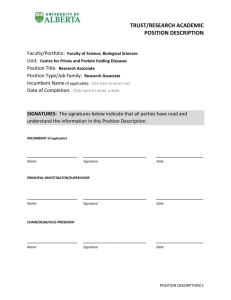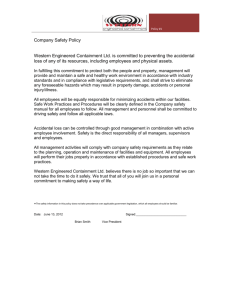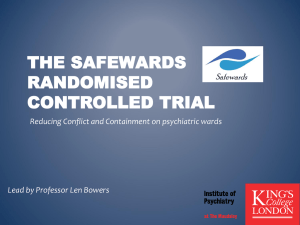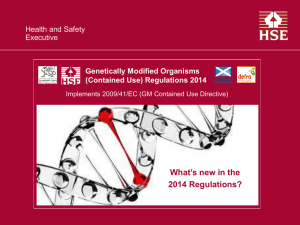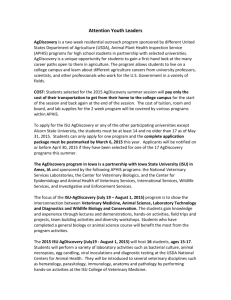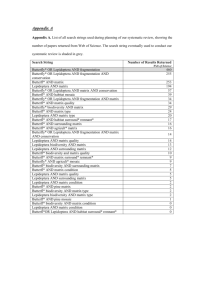United States Department of Agriculture
advertisement
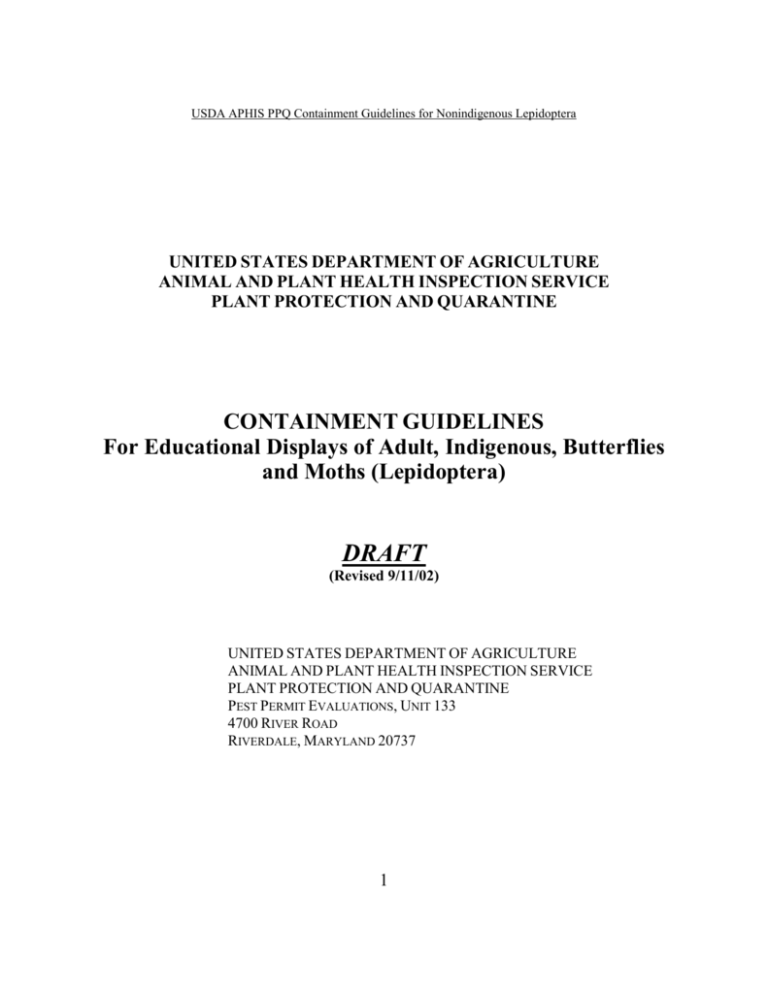
USDA APHIS PPQ Containment Guidelines for Nonindigenous Lepidoptera UNITED STATES DEPARTMENT OF AGRICULTURE ANIMAL AND PLANT HEALTH INSPECTION SERVICE PLANT PROTECTION AND QUARANTINE CONTAINMENT GUIDELINES For Educational Displays of Adult, Indigenous, Butterflies and Moths (Lepidoptera) DRAFT (Revised 9/11/02) UNITED STATES DEPARTMENT OF AGRICULTURE ANIMAL AND PLANT HEALTH INSPECTION SERVICE PLANT PROTECTION AND QUARANTINE PEST PERMIT EVALUATIONS, UNIT 133 4700 RIVER ROAD RIVERDALE, MARYLAND 20737 1 USDA APHIS PPQ Containment Guidelines for Nonindigenous Lepidoptera CONTENTS I. PURPOSE OF THIS DOCUMENT II. CONSTRUCTION STANDARDS FOR THE ENTIRE STRUCTURE Location and Identification Floor Plan Doors HVAC System Electrical System Plumbing System Vacuum Systems III. CONSTRUCTION STANDARDS FOR SPECIALIZED ROOMS Glasshouse Public Display Room Vestibules IV. EQUIPMENT STANDARDS Sterilization or Decontamination Equipment Cages and Containers 2 USDA APHIS PPQ Containment Guidelines for Nonindigenous Lepidoptera I. PURPOSE OF THIS DOCUMENT These guidelines are a reference to help you prepare to comply with the USDA APHIS regulations that oversee import, interstate transport, and possession of organisms regulated by the Plant Protection Act of 2000. The guidelines will help in designing, building, maintaining, and operating a containment facility for indigenous, known species of butterflies and moths (Lepidoptera) from pure cultures. Indigenous butterflies and moth require containment under permit if they are not found in that area, and are moved across state lines. The adults are typically displayed in free-flight enclosures accessible to the public. They may be used in educational displays in zoos, museums, and other public facilities (limitations will be stipulated in the PPQ 526 Permit conditions). Butterflies under permit may not be released to the environment or moved from containment without further permits. These Lepidoptera may be contaminated with organisms, such as: plants, Arthropods, plant parts, parasitoids, hyperparasites, plant and Arthropod disease organisms, etc. During inspections or re-inspections of your facility, USDA, APHIS, PPQ personnel will review these guidelines and any risk mitigation instructions that may accompany your permit. USDA, APHIS, PPQ, Pest Permit Evaluations Staff in Riverdale, Maryland will determine when your facility meets containment standards so that federal permits for organisms you apply for may be issued. Components of this Document: To enable issuance of your permit(s), your containment site must meet the Performance Standards listed in the gray, shaded boxes. Numerous engineering designs may be available to help you meet these standards. We strongly encourage you to discuss engineering aspects with qualified professionals. Professionals know State, local and Federal laws that regulate construction. PPQ only evaluates the physical and operational containment characteristics of a facility, and does not regulate the installation of emergency doors, vestibule doors, incinerators, air intake and exhaust ducts, emergency lighting, plumbing, and many other features. In addition, the design, construction and operation of your containment facility may vary depending on the organisms you wish to contain and your geographic location. The Suggestions listed under each Performance Standard are methods or equipment that commonly are used at this time to accomplish each containment standard. This document offers information on construction, equipment, and operational topics that PPQ currently considers prior to issuing a permit for non-indigenous Lepidoptera used in public displays. However, you 3 USDA APHIS PPQ Containment Guidelines for Nonindigenous Lepidoptera may have alternative methods to contain these organisms. USDA, APHIS, PPQ welcomes alternatives that are proven to meet or exceed the standards. To insure timely permitting, please review this document, and research design alternatives. Once design options are narrowed, call or fax PPQs Containment Facilities group at (301) 734-5304 or FX (301) 734-5392 and continue discussions as the facility is planned and built. PRIMARY PERFORMANCE CRITERIA- Lepidoptera Display The inspection and permitting procedures of the USDA APHIS PPQ are intended to prevent the unpermitted release of indigenous Lepidoptera and possible associated contaminants into the environment of the United States. Accidental or purposeful release of these Lepidoptera may be violation of the Federal Plant Protection Act. These Performance Criteria apply to all containment facilities and permits issued to those facilities as described by this document. II. CONSTRUCTION STANDARDS FOR THE ENTIRE CONTAINMENT STRUCTURE CONSTRUCTION STANDARD A. Locate the facility in areas with minimal environmental risk. Identify the facility as dedicated and secure. SUGGESTIONS: 1. Design the containment facility as a separate, dedicated building. If this is not possible, design and build to prevent pest escape. 2. At the public or main entry, post: A sign stating , USDA APHIS PPQ Inspected Containment facility, that unauthorized release of butterflies may be punished by fines. Emergency telephone numbers (24 hours) for persons responsible for contained organisms. 4 USDA APHIS PPQ Containment Guidelines for Nonindigenous Lepidoptera CONSTRUCTION STANDARD B. Design the Floor Plan of the facility to prevent escape of the enclosed Lepidoptera. SUGGESTIONS: 1. Plan at least two adjacent rooms for the contained Lepidoptera; The first room or Receiving Room, is for the receipt of packages and manipulation of Lepidoptera pupae. This room may be a glasshouse, and it may include a laboratory and other rooms. This room can not be accessible to the public and must be lockable. The second room is for the public display of contained adult Lepidoptera . This room may also be a glasshouse. 2. Build a vestibule at each entrance and/or exit of the Receiving Room and the Display area. The exterior vestibule door of the Receiving Room may open into the Display area, or into the interior of the vestibule of the Display area. Enclosed lobbies, gift shops, etc. may count as a vestibule chamber for the display area, but not for the Receiving Room. 3. See section III. CONSTRUCTION STANDARDS FOR SPECIALIZED ROOMS for recommended features of the Receiving Room, the public Display Room, Glasshouse, Restrooms, and Vestibules. 4. Build offices outside of containment areas. 5. Install self-closing doors throughout the containment areas. 6. Install exterior doors that lock. 7. Block the windows of the most interior doors leading from the containment rooms with blinds or other covers to prevent flying Lepidoptera from moving toward light, toward the doors and beyond. CONSTRUCTION STANDARD C. Install Doors that contain the organism and contribute to the security of the facility. SUGGESTIONS: 5 USDA APHIS PPQ Containment Guidelines for Nonindigenous Lepidoptera 1. 2. 3. 4. Install self-closing doors throughout the containment areas. Install exterior doors that lock. Lock emergency exit doors from the outside. Install doors that seal completely to their frames and have floor sweeps. Use doors that are windowless or have windows covered by blinds. 5. Doors for vestibules into the Receiving Room must completely seal to their frames and thresholds with gaskets, seals and sweeps (e.g., rubber, Neoprene, magnetic, door sweeps). 6. Post signs on the exterior and interior of the emergency door that state, USDA-APHIS Containment Facility - Emergency Exit Only. 7. Install audible alarms that activate when emergency exit doors are opened. CONSTRUCTION STANDARD D. Design and install an HVAC System (Heating, Ventilation and Air Conditioning) that prevents escape of the contained organisms. SUGGESTIONS: 1. Install screen over all air sources and exhaust vents to prevent the entrance of local organisms and exit of contained organisms. For information on the size of the mesh screens, check the specific type of containment room for prescribed screen size. 2. Install screens in the HVAC system so they are easy to clean and replace. III. CONSTRUCTION STANDARDS FOR SPECIALIZED ROOMS CONSTRUCTION STANDARDS FOR SPECIALIZED ROOMS A. Build Glasshouses to prevent the escape of any Lepidoptera. (Glasshouses may be used for Display and/or Receiving Rooms. If used for these purposes, also review the standards listed under Display and/or Receiving Rooms rooms.) 1. SUGGESTIONS: 1. Install a frame strong enough to support the translucent walls and ceilings under all 6 USDA APHIS PPQ Containment Guidelines for Nonindigenous Lepidoptera anticipated weather conditions (snow, ice, wind, etc.). 2. Install translucent wall and ceiling materials strong enough to guarantee the security of the facility. Examples of acceptable materials are; Plexiglas, lumite, lexan, safety glass, and wire-reinforced glass. Polyethylene, vinyl or plastic sheeting is NOT acceptable. 3. Seal junctions and joints between frame, panels, walls, and foundation with a suitable caulk or equivalent material. CONSTRUCTION STANDARDS FOR SPECIALIZED ROOMS B. Build Public Display Rooms with security and containment features that allow entry and exit of visitors, but prevent exit of contained Lepidoptera. SUGGESTIONS: 1. Minimize the number of entry and exit areas to help monitor visitors. 2. Install a vestibule at each entry and/or exit to this room. (See section III. CONSTRUCTION STANDARDS FOR SPECIALIZED ROOMS Vestibules.) CONSTRUCTION STANDARDS FOR SPECIALIZED ROOMS C. Vestibules SUGGESTIONS: 1. Install a vestibule in each entry and /or exit to the Receiving Room and Display Room. 2. Build each vestibule at least 6 feet in length from door threshold to door threshold. 3. Insure that vestibules are darker than adjacent rooms. 4. Insure vestibule doors interlock so that only one door can be opened at a time (check with local fire code). 5. Install thresholds and gaskets that seal the exterior and interior doors with their frames and thresholds. Include sweeps on the bottom of the doors. 6. Install full-length mirrors on the walls of the exit vestibule to help visitors check themselves for hitchhiking Lepidoptera. 7. Post a sign in the public exit vestibule stating “Removal of Butterflies and Moths is a 7 USDA APHIS PPQ Containment Guidelines for Nonindigenous Lepidoptera Violation of USDA Regulations and may Result in Civil or Criminal Penalties.” 8. Lobbies, gift shops, darkened hallways or other relatively large areas may serve as a vestibule for the display area, only if the features of the interior doorways prevent adult Lepidoptera from escaping into these areas. However, USDA recommends that these areas serve only as secondary chambers that are connected to primary vestibules. IV. EQUIPMENT STANDARDS EQUIPMENT STANDARD A. Use equipment to Sterilize or Decontaminate solid waste (e.g. organisms, soil, plant material, solid waste, and contaminated or infested articles) before removing it from the facility. SUGGESTIONS: 1. Supply the Receiving Room with insect killing jars, alcohol (at least 70%), and bleach solutions (at least 10%) to kill undesirable organisms (e.g., parasitoid and pathogens) and decontaminate other biological materials (e.g., cocoons, emerged chrysalis exuvia). 2. A freezer or microwave may be used to kill organisms, but are not approved to sterilize or decontaminate materials, including dead organisms. EQUIPMENT STANDARD B. Lepidoptera and parasitoids. Use a chrysalis emergence chamber to confine 8 USDA APHIS PPQ Containment Guidelines for Nonindigenous Lepidoptera SUGGESTIONS: 1. Construct that prevents escape of parasites and adult butterflies. Most exhibits want emergence chambers to be viewable by the visitor as part of the life cycle story. To do this, the chamber is often constructed with plastic sheeting (e.g. Acrylic, Plexiglass, Lexan). The chamber will require ventilation openings that must be covered with 60+ mesh screen. This means 60 divisions per linear inch in each direction. Metallic or other material are acceptable for screening. The chrysalides are hung inside for emergence and accessed through a door that locks and seals tightly. The interior of the emergence chamber should be painted a light color so parasitoids can be easily sean. There should be no hiding places for parasitoids in the material used to suspend the chrysalids. Parasitoids will go to the top and to the corners of the chamber. Aspirators or paint brushes dipped in alcohol or soapy water can be used to eliminate the occasional parasitoid. 9 USDA APHIS PPQ Containment Guidelines for Nonindigenous Lepidoptera 10
